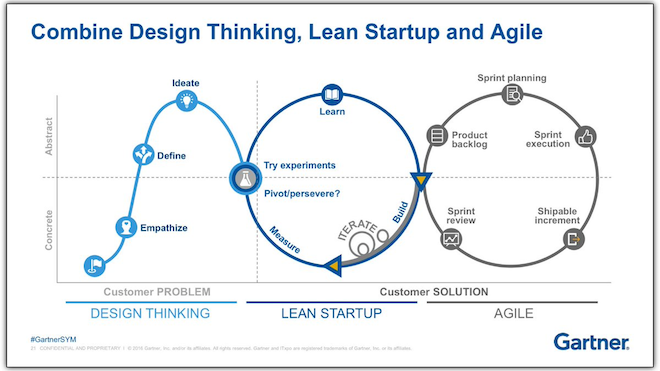Agility has been the subject of numerous theories, publications and conferences for several years. The concept was historically created during a gathering of software development experts in 2001. They explain the ins and outs of what we know as « agile » through a founding document called the “agile manifesto“, which encompasses 4 values and 12 principles. At the time, it was mainly a solution proposed by developers to manufacture a software in the most efficient way while guaranteeing its adequacy with the needs of the customer. 17 years later, things have changed, and the agile manifesto provides only part of the answers to bring out a new product or service with what specialists call a good time-to-market and a good product market fit in the digital age.
What does it mean to be agile these days?
The 17 founders of “agility” initially set 4 values for “agile” working that are still used today. As a rule, they must be extended to the entire organization of the company and not limited into IT projects, which is very often the case.
These values are:
– People and their interactions more than processes and tools
– Operational software more than exhaustive documentation (we could replace the term “software” by “product” or “service”)
– Collaboration with customers more than contractual negotiation
– Adapting to change more than following a plan
These common sense values should, in my view, be posted on the walls of all companies and should guide the decisions and operations of any organization. They’ve have lead to the creation of several theoretical methods including Scrum, which is by far the most used method in organizations. The Kanban, method, which came from the automotive industry (Toyota) it is used to continuously improve production processes for waste less production management.
But agile methods ultimately represent only the small link in a more global chain that must be put into place to really design and develop new products or services in agile mode. The best approach is to combine several complementary methods such as design thinking, lean startup and agile.

Design thinking refers to all the methods and tools that help creators to apply the same approach that a designer would apply when faced with a problem or an innovation project. It is an approach to innovation and its management that is a synthesis between analytical thinking and intuitive thinking. It relies heavily on a co-creativity process involving end-user feedback. Experience increasingly dominates the economy making design thinking so popular for the nearly 30 years since its creation.
For its part, Lean startup is a specific approach to starting an economic activity and launching a product. It is based on scientific experimentation and iterative design. The concept refers to the idea that a business or activity is only likely to succeed if it gives itself the time it needs to study the market before launching itself.

Together these methods ensure creators always imagine, design, develop and market a product while always keeping end user expectations in mind. When correctly applied, strategies using these methods will consider all of the following: Don’t start without being sure that there is a real and proven problem to which you are trying to respond. Don’t start developing something without checking that the solution you are proposing provides a real answer to the problem identified. It also important to remember to always listen to your customers when developing your solution and correct any issues as soon as possible in the event of a change of opinion or strategy. In using these tools and methods, you understand that all this is in no way linear and that you can go back completely and adapt at any time.
Adapting to change and its market
Being agile in 2018 is about knowing how to adapt to your market, to increasingly rapid changes and to the emergence of new needs or new competitors above all. The rigidity of the historical management processes of companies have made them hyper-hierarchical monoliths that are highly structured and unable to adapt to change without major cost sacrifices. Introducing agility into your business when it has never been the case is always a challenge. Some solutions such as business agility exist, which take into account all aspects of company management such as governance, budget management, sourcing or organization for example.
 Sébastien Bourguignon
Sébastien Bourguignon
As manager at a consulting firm, Sébastien works in the banking and insurance sector. He is an expert in computer science, innovation and startups, with 15 years of experience in the digital, new tech and agility domains. He adds value by rapidly transforming companies and allowing them to increase their performance with new digital technology.
